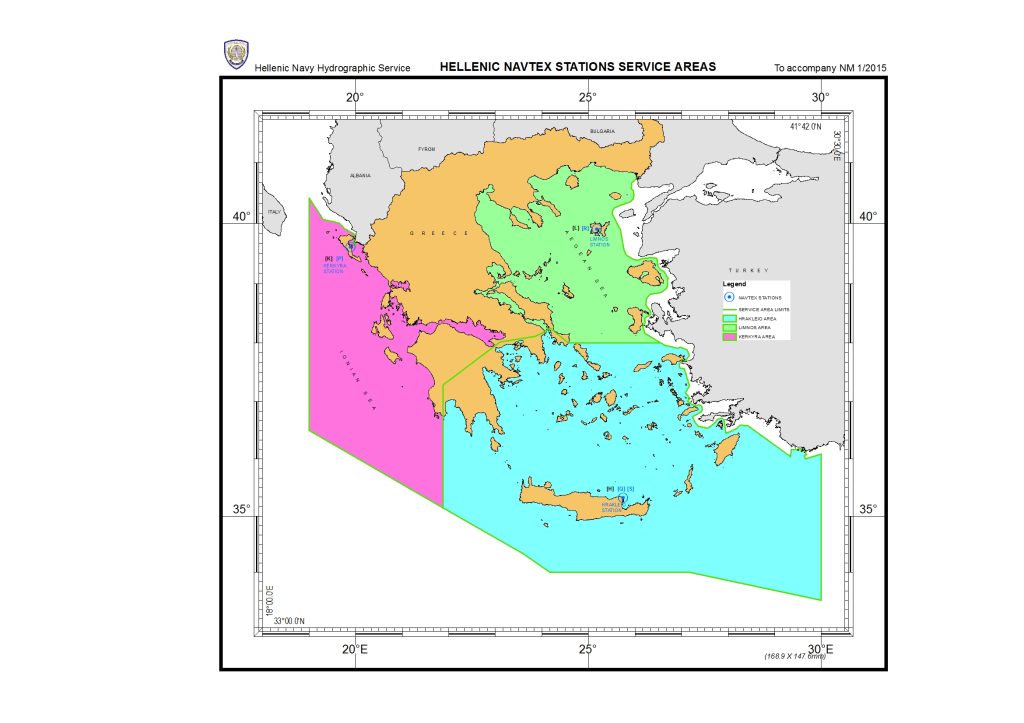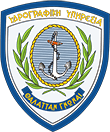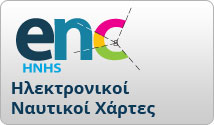NAVTEX

NAVTEX is an international offered Service aiming to the dissemination, in sailing ships, of navigational, meteorological and of urgent information that concern the shore sea areas. The information is gathered automatically and printed directly by telex.
NAVTEX establishment has been agreed, in common, by the International Organizations IHO (International Hydrographic Organization) and IMO (International Maritime Organization) (IMO Sub-Committee on RadioCommunications – 31st session – COM/31/5/4//13 Mar 1986 and IMO MSC 54 – COM/circ. 99//8 May 1987) and is a part of the Global maritime Distress and Safety System (GMDSS), which is developed inside IMO framework. The Greek NAVTEX Service belongs to the Mediterranean area NAVAREA III, whose coordinator is the Spanish Hydrographic Service.
NAVAREA III navigational warnings can be seen here.
NAVTEX International Service 518 kHz
For the implementation of NAVTEX International Service in Greece three (3) stations have been founded, after IMO approval, each one serving a specified sea area. Emissions are made by telex (type of emission F1B) in frequency 518 kHz in English language.
NAVTEX National Service 490 kHz
After a request made by HNHS and approved by IMO, on February 1st, 2012, the NAVTEX National Service was founded and set to order to the 490 kHz frequency in Greek language.
NAVTEX emissions are programmed to be made every four (4) hours, have a maximum duration of ten (10) minutes and are complied with the emission program issued by IMO.
Urgent and vitally important messages (i.e. search and rescue information, storm warning etc ) are emitted exceptionally.
The NAVTEX receiver must be activated at least twelve (12) hours prior the ship sailing or should remain operational constantly. It is programmed to receive automatically from selected station specific message categories. A computer controls receiving messages, so as they are not been reprinted in their entirety during the forthcoming emissions, but only their prefix.
All NAVTEX messages have a prefix consisting of a group of four (4) alpha numeric characters, B1, B2, B3, B4:
The first character B1 (letter) defines the identity of the emitting station.
The second character B2 (letter) defines the category of the message (as described below).
The third and fourth character B3, B4 (numeric) are the serial number of the message numbered from 01 up to 99. Subsequently, the numbering starts again from 01, avoiding valid NAVTEX numerics.
Exceptionally transmitted messages deemed to be necessarily received by the ships, get the serial number 00 in order not to be rejected by the receiver, but to be printed always, regardless of programming.
The second character B2 (letter) of the message prefix, suggests the category of the message where the following letters are being used (characters):
A- Navigationalwarnings.
B- StormyWindsWarning.
C- Icereports.
D- Search&rescueinformation.
E- Weatherreport.
F- Pilot service messages.
G- DECCA messages.
H- LORAN messages.
I- OMEGA messages.
J- STANAV messages.
K- Other electronic navaid messages.
L- Navigational warnings-additional to letter A.
Z- No message on hand.
The Greek seas services with NAVTEX messages issued in the English and Greek language (International and National NAVTEX Service) and are transmitted by three (3) Greek Stations installed in IRAKLEIO (35’ 19’ 19,7’’ – 25’ 44’ 54,9’’) with character [H], [Q], [S] respectively for the South Aegean, in KERKYRA (39’ 36’ 25,7’’ – 19’ 53’ 28,4’’) with character [K], [P] respectively for the Ionian Sea and LIMNOS (39’ 54’ 24,7’’ – 25’ 10’ 50,7’’) with character [L], [R] respectively for the Aegean. The area of service for each station as well as its limits are shown in the map entitled “GREEK NAVTEX STATIONS- AREA OF SERVICE”.
NAVTEX International Service 518 kHz
Emission hours of the aforementioned NAVTEX stations are:
HERAKLION [H]: 01:10 – 05:10* – 09:10* – 13:10 – 17:10* – 21:10*, UTC
KERKYRA [K[: 01:40 – 05:40* – 09:40* – 13:40 – 17:40* – 21:40*, UTC
LIMNOS [L[: 01:50 – 05:50* – 09:50* – 13:50 – 17:50* – 21:50*, UUTC
*Weather reports also emitted
NAVTEX National Service 490 kHz
Emission hours of the aforementioned NAVTEX stations are:
HERAKLION [Q]: 02:40 – 06:40 – 10:40* – 14:40 – 18:40* – 22:40, UTC
KERKYRA [P]: 02:30 – 06:30 – 10:30* – 14:30 – 18:30* – 22:30, UTC
LIMNOs [R]: 02:50 – 06:50 – 10:50* – 14:50 – 18:50* – 22:50, UTC
*Weather reports also emitted
NAVTEX National Service 4209,5 kHz
HERAKLION [S]: 03:00 – 07:00 – 11:00* – 15:00 – 19:00* – 23:00, UTC
HNHS has assumed the role of coordinator for the collection, processing and transmission, for further message emission by the NAVTEX stations that concern the Greek seas, with competent services the Hellenic National Meteorological Service (HNMS) and the Hellenic Coast Guard (HCG).
Exceptional Stormy Winds or Storm Forecasts are emitted immediately after their issuance.
For valid NAVTEX messages, please press here.






